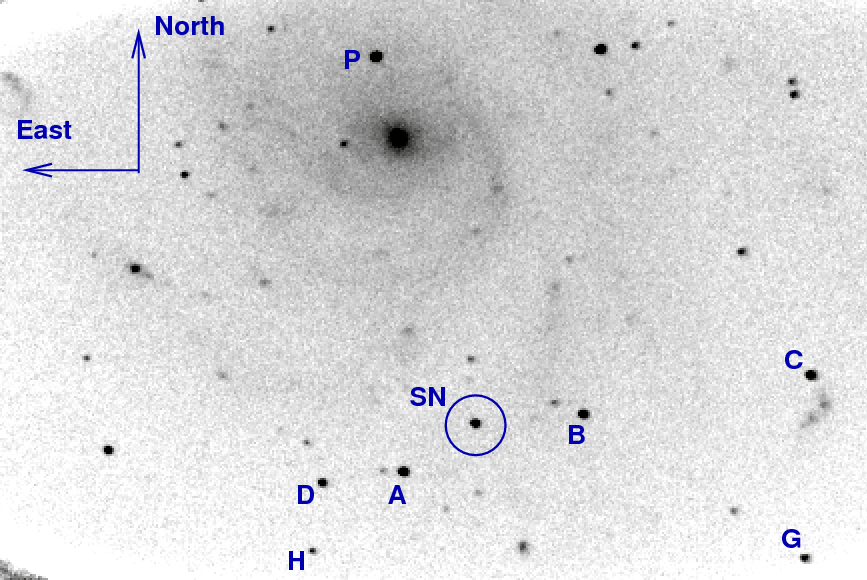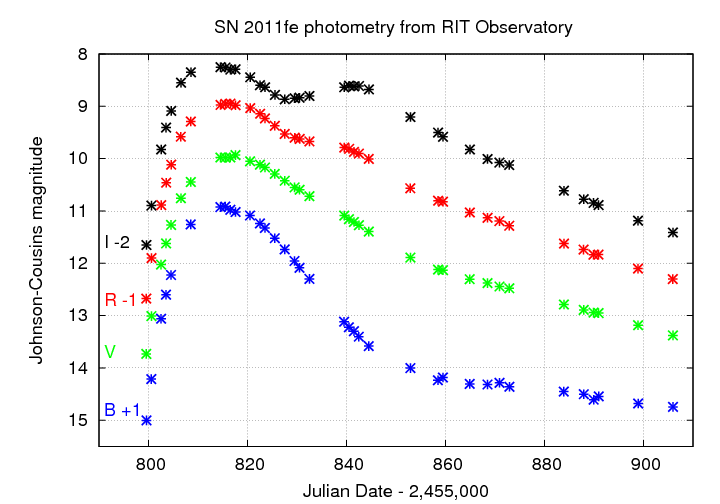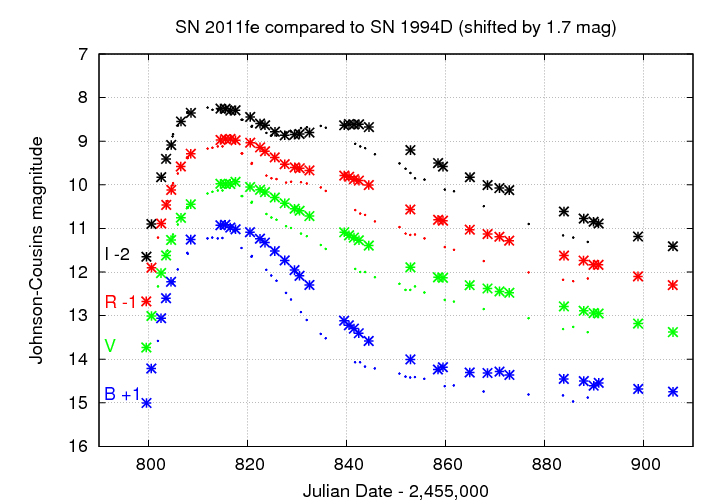
On the night of Dec 09/10, 2011, I observed the newly discovered supernova known as PTF 11kly = SN 2011fe in the galaxy M101.
The setup was:
Notes from the night
This is a chart of the field of SN 2011fe, based on a stack of five R-band images. The field of view is about 10 by 8 arcminutes.

The marked objects appear in a list of comparison stars with magnitudes in BVRI, created by the AAVSO. You can find the original at the AAVSO web site; go to the Variable Star Plotter (VSP) area. I've made a simplified ASCII version of the catalog below, or you can look at the AAVSO's original version in a local copy.
#AUID RA. Dec. Label U B V Rc Ic J H K Comments # Label RA Ra(deg) Dec Dec(deg) ID U B V R I 000-BKD-527 14:03:49.86 [210.95775d] 54:09:05.8 [54.15161d] 117 x - 12.268 (0.057)29 11.735 (0.040)29 11.359 (0.048)29 11.006 (0.054)29 - - - 000-BKD-528 14:04:21.68 [211.09033d] 54:19:22.4 [54.32289d] 119 x - 12.572 (0.068)29 11.948 (0.047)29 11.528 (0.056)29 11.134 (0.063)29 - - - 000-BKD-529 14:02:00.79 [210.50330d] 54:23:15.8 [54.38772d] 128 x - 13.553 (0.062)29 12.751 (0.031)29 12.253 (0.045)29 11.788 (0.056)29 - - - 000-BKD-530 14:01:55.32 [210.48050d] 54:16:21 [54.27250d] 131 x - 13.540 (0.064)29 13.094 (0.044)29 12.716 (0.051)29 12.361 (0.056)29 - - - 000-BKD-531 14:02:02.00 [210.50833d] 54:20:43.9 [54.34553d] 133 x - 14.188 (0.094)29 13.291 (0.057)29 12.772 (0.074)29 12.287 (0.088)29 - - - 000-BKD-532 14:01:49.79 [210.45746d] 54:23:02.7 [54.38408d] 134 x - 14.187 (0.047)29 13.436 (0.033)29 12.970 (0.049)29 12.534 (0.061)29 - - - 000-BKD-533 14:03:13.67 [210.80696d] 54:15:43.4 [54.26205d] 138 A - 14.699 (0.091)29 13.801 (0.046)29 13.230 (0.062)29 12.698 (0.074)29 - - - 000-BKD-534 14:02:54.17 [210.72571d] 54:16:29.5 [54.27486d] 140 B - 14.557 (0.107)29 13.991 (0.074)29 13.581 (0.078)29 13.197 (0.083)29 - - - 000-BKD-535 14:02:29.54 [210.62308d] 54:16:55.2 [54.28200d] 141 C - 14.959 (0.102)29 14.100 (0.045)29 13.598 (0.063)29 13.130 (0.077)29 - - - 000-BKD-536 14:02:31.15 [210.62979d] 54:14:03.9 [54.23442d] 146 G - 15.158 (0.078)29 14.605 (0.029)29 14.204 (0.061)29 13.828 (0.082)29 - - - 000-BKD-540 14:01:50.86 [210.46191d] 54:16:08.1 [54.26892d] 149 x - 15.373 (0.010)29 14.925 (0.000)29 14.635 (0.006)29 14.361 (0.008)29 - - - 000-BKD-538 14:03:23.74 [210.84892d] 54:14:32.6 [54.24239d] 155 H - 16.015 (0.042)29 15.475 (0.000)29 15.133 (0.046)29 14.811 (0.065)29 - - - 000-BKD-539 14:03:05.64 [210.77350d] 54:17:26.2 [54.29061d] 162 x - 16.776 (0.091)29 16.177 (0.000)29 15.640 (0.079)29 15.140 (0.112)29 - - - #Report this sequence as: 5249bgj in the chart field of your observation report. This table is for a 0.25000° fov around PTF11KLY, RA: 14:03:05.81 (210.77421) & Decl.: 54:16:25.40 (54.27372).
Up to this point, I have been extracting magnitudes from each 60-second image, then analyzing those measurements via an ensemble method. Since the SN is growing faint in I-band, and reference stars have always been faint in B-band, I decided to try a different technique: combine all the images taken in one filter via a median filter, then measure magnitudes from one single combined image in each passband. On the two most recent nights, the two methods produce results which differ by (in magnitudes)
median - individual B V R I ----------------------------------------------------------- Dec 2 UT -0.012 0.010 0.007 0.003 Dec 10 UT 0.007 -0.006 -0.007 -0.011 -----------------------------------------------------------
My estimate for the uncertainty in the instrumental magnitude of the SN -- based on the scatter from mean of the measurements taken from individual images -- is around 0.02 - 0.03 magnitudes at this time; there is additional (systematic) uncertainty due to the calibration of the comparison stars. I conclude that at this time, the two methods produce results which are identical to within the uncertainties. In the future, I will combine individual images and extract a single instrumental magnitude for each passband. (Actually, I'll continue to do the analysis both ways, but I'll report only the median value).
I measured the instrumental magnitude of each star with aperture photometry, using a radius of 3 pixels = 5.6 arcseconds in BV and a radius of 4 pixels = 7.4 arcseconds in RI, and sky defined by an annulus around each star. Following the procedures outlined by Kent Honeycutt's article on inhomogeneous ensemble photometry, I used all stars available in each image to define a reference frame, and measured each star against this frame.
Below is a graph of the scatter in differential magnitude versus magnitude in the ensemble solution for the R-band.

Tests over the past week have indicated that, although stars A, B, C, G and H have photometry from the AAVSO, the best results occur when I discard H. It is significantly fainter than the others, and almost always is an outlier from the photometric solution.
Applying the color corrections determined on UT Aug 27 to the ensemble photometry of SN 2011fe and the comparison stars in its field, I find the magnitude of SN 2011fe on this night was
Passband JD-2,455,000 Mag +/- ------------------------------------------------- B 905.951 13.75 0.11 V 905.943 13.38 0.06 R 905.917 13.30 0.07 I 905.933 13.41 0.07 -------------------------------------------------
The uncertainties here are dominated by the uncertainties in the magnitudes of the comparison stars provided by the AAVSO. Note that the SN is now fading to the point that it is not the brightest object in R and I; I will start keeping track of the scatter in its ensemble mean value, rather than that of the brightest stars in the ensemble.
I have reported these measurements to the AAVSO via their WebObs tool ....
You can find a complete set of the RIT Obs measurements by grabbing the file sn2011fe_mags.out. I've plotted our measurements in two graphs. First, the measurements of SN 2011fe so far:

Second, the new SN compared to another Type Ia SN, SN 1994D in NGC4526. I've shifted the SN 1994D measurements in time and in magnitude so that they sort of match the early observations of SN 2011fe.

Last modified 12/10/2011 by MWR.